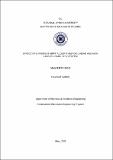Please use this identifier to cite or link to this item:
http://hdl.handle.net/11547/9528Full metadata record
| DC Field | Value | Language |
|---|---|---|
| dc.contributor.author | SAEED, HALMAT | - |
| dc.date.accessioned | 2023-06-14T11:03:41Z | - |
| dc.date.available | 2023-06-14T11:03:41Z | - |
| dc.date.issued | 2021 | - |
| dc.identifier.uri | http://hdl.handle.net/11547/9528 | - |
| dc.description.abstract | The output power of a PV array is dependent on environmental factors such as solar irradiation and temperature, So, it has a non-linear I-V characteristic. Maximum Power Point (MPP) is a point on the I-V, P-V characteristic curve of a PV array where the PV device generates maximum output power. The location of MPP shifts as the climate changes. MPPT's aim is to keep the solar operating voltage as similar to MPP as possible under changing environmental conditions. They must run at their MPPT considering the inhomogeneous shift in environmental conditions in order to continuously gather the full power from the PV array. here the most commonly used MPPT algorithms for PV applications are illustrated because they are easy to implement which are Perturb and Observe (P&O), Hill Climbing (HC) and Incremental Conductance (INC). In this paper, the applications of those three MPPT algorithms in PV systems at linear and nonlinear loads have been investigated. Comparative analysis has been done and the efficient one based on different testing scenarios has been determined based on output results | tr_TR |
| dc.language.iso | en | tr_TR |
| dc.publisher | ISTANBUL AYDIN UNIVERSITY INSTITUTE OF SOCIAL SCIENCES | tr_TR |
| dc.subject | MPPT | tr_TR |
| dc.subject | PV System | tr_TR |
| dc.subject | linear load | tr_TR |
| dc.subject | non-linear load. | tr_TR |
| dc.title | EFFECT OF DIFFERENT MPPT ALGORITHM FOR LINEAR AND NON LINEAR LO | tr_TR |
| dc.type | Thesis | tr_TR |
| Appears in Collections: | Tezler -- Thesis | |
Files in This Item:
| File | Description | Size | Format | |
|---|---|---|---|---|
| 10420321.pdf | 2.13 MB | Adobe PDF |  View/Open |
Items in DSpace are protected by copyright, with all rights reserved, unless otherwise indicated.
